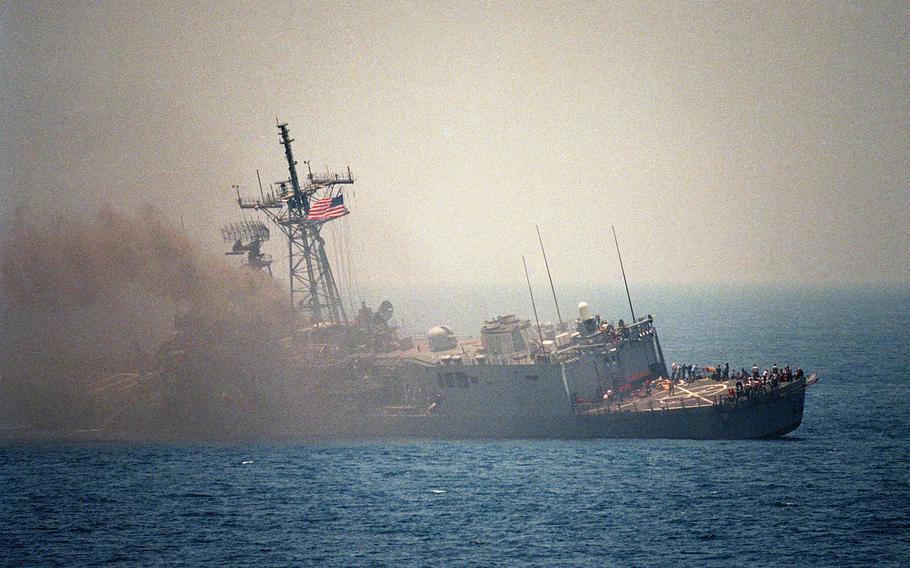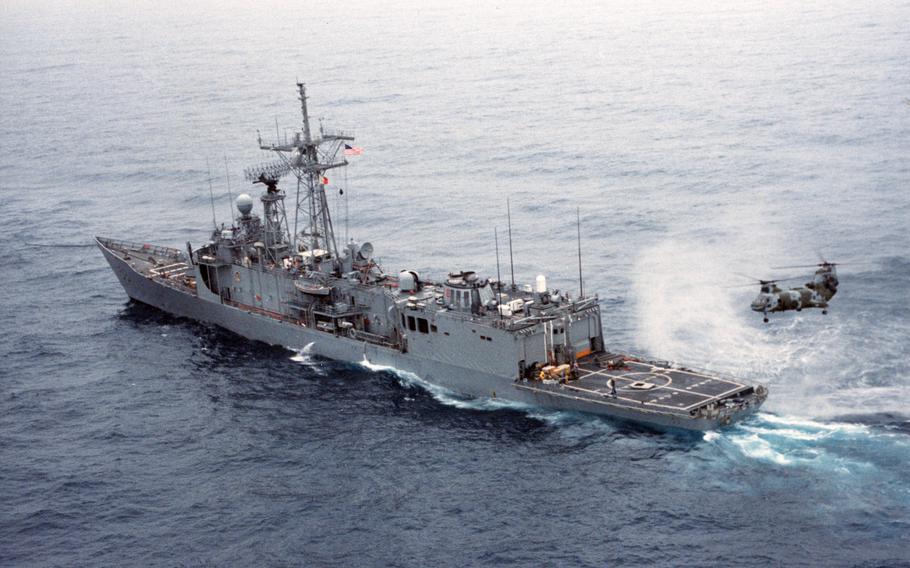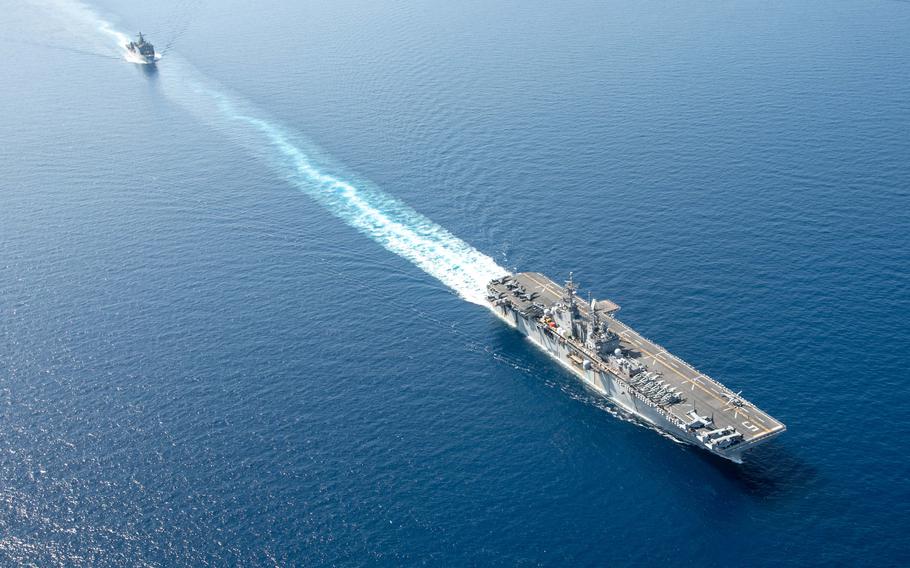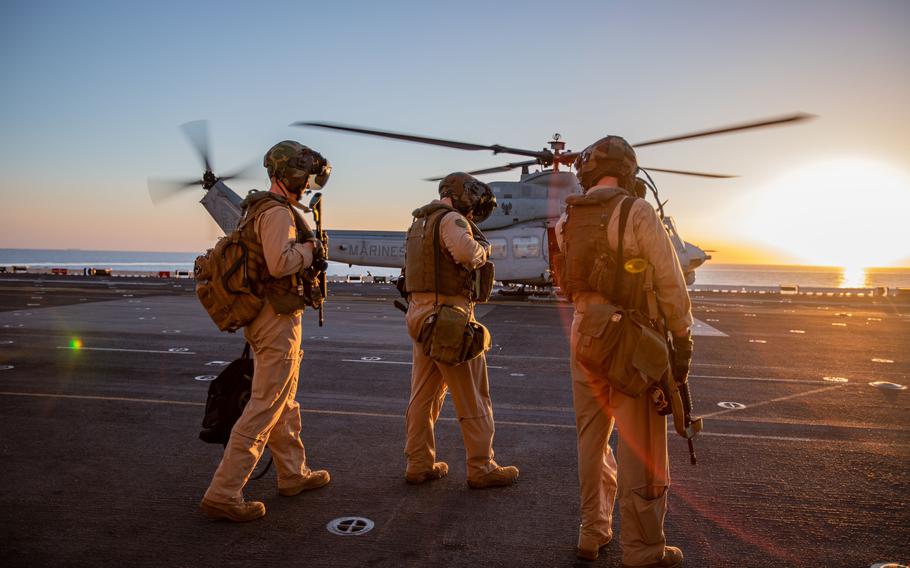
The guided missile frigate USS Stark listing to port after being struck by an Iraqi-launched Exocet missile May 18, 1987. (U.S. Navy/ National Archives)
A resurgence in tensions between the U.S. and Iran in Middle Eastern waters is harkening back to the playbook of clandestine maritime conflicts that has pitted the two countries against each other for more than four decades, according to analysts.
Approximately 3,000 Marines and sailors landed in the Middle East this week, ostensibly to prevent Iranian interference with commercial shipping in the Persian Gulf.
The military buildup, which includes recent deployments of a naval destroyer and advanced fighter aircraft squadrons, comes on the heels of U.S. claims that Iran has harassed or seized 20 commercial ships since 2021.

USS Samuel B. Roberts underway after the ship struck a mine on April 14, 1988. (U.S. Navy)
The Iranian military responded with a warning this week saying it may seize U.S. vessels on the basis of any perceived provocations, as reported by Al-Monitor, a regional news outlet.
Iran also launched unannounced military exercises last week that showcased new missile systems, Al Jazeera reported Aug. 2.
The latest round of saber-rattling recalls similar episodes, notably the Tanker War of the 1980s, when both nations’ naval forces openly engaged in hostilities, said Nicholas Carl, an Iran specialist at the American Enterprise Institute.

The amphibious assault ship USS Bataan and dock landing ship USS Carter Hall sail together in the Red Sea on Aug. 8, 2023. Components of the Bataan Amphibious Ready Group and the 26th Marine Expeditionary Unit are deployed to the U.S. 5th Fleet area of operations. (Jeffrey Cordero/U.S. Marine Corps)
The Tanker War started as part of the conflict between Iraq and Iran from 1980 to 1988. First Iraq and then Iran began attacking oil tankers and commercial ships.
The U.S. stepped in and began escorting reflagged oil tankers in 1987. After an Iranian mine struck and almost sank the USS Samuel B. Roberts in 1988, the U.S. launched a one-day operation that sank five Iranian boats, including a frigate.
Many tactics the Iranian military uses today, such as swarming with small fast boats, developed out of necessity during the Tanker War, said Farzin Nadimi, a senior fellow at the Washington Institute.
In the decades since, Iran has expanded its capabilities, developing cruise missiles, aerial drones, bomb and missile boats and fortified islands.

U.S. Marines prepare to board a UH-1Y Venom during a rehearsal on the USS Bataan in the Red Sea on Aug. 7, 2023. ( Nayelly Nieves-Nieves/U.S. Mari)
“They are much more capable of fighting a direct conflict today than they were three decades ago,” Nadimi said.
However, despite their public bravado, Iran’s leaders are aware of the country’s limitations in a conventional conflict against the U.S., and they do not want open naval warfare, such as what occurred during the Tanker War, analysts said.
A full-scale conflict that includes attempts to shut down shipping through the Strait of Hormuz also would run counter to the interests of major stakeholders like China, a crucial Iranian partner heavily reliant on oil from the Middle East, analysts said.
Even during the Tanker War, Iran was unable to stop the flow of commercial shipping through the Strait of Hormuz despite its best efforts, said Martin Navias, a research fellow at King’s College in London who wrote a much-cited book about the conflict.
Instead, Tehran seeks to use proxies or conduct shadowy operations so as to claim plausible deniability, antagonizing its adversaries without inviting open warfare, analysts said.
This was evident in a series of limpet mine attacks on oil tankers in 2019 that the U.S. blamed on Iran. Tehran denied responsibility.
The most recent flareup seems to be a tit-for-tat move in which Iran is telling the U.S. to stop seizing its ships as part of sanctions against the country, Carl said.
“At the end of the day, their objective is to influence American policymakers,” he said. “It’s not to achieve some decisive military victory over the United States because they realize that’s not really in the cards.”
Nevertheless, saber-rattling and military shows of force can increase the risk of unintended escalation, as illustrated by two tragedies during the Tanker War that resulted from mistaken identity.
In one, an Iraqi jet fired on the frigate USS Stark in 1987, killing 37. In another, the missile cruiser USS Vincennes shot down an Iranian civilian airliner with 290 people on board in 1988, reportedly believing it was a fighter jet.
And amid more acrimony between Washington and Tehran in 2020, Iran shot down a Ukrainian civilian airliner, apparently thinking it was an American cruise missile. All 176 people on board w.ere killed.
“As we saw back in the Tanker War, when we have U.S. and Iranian forces operating in such close proximity to one another in such an unstable and unpredictable environment, there is always the potential for miscalculation and for tensions to flare unexpectedly,” Carl said.